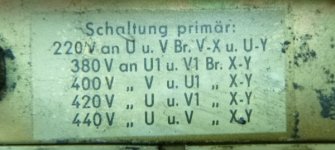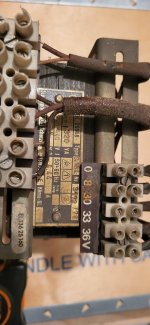If I understand correctly, this is the primary winding diagram:
Connect U to Y, and connect V to X will paralleled both primary windings for 220V input.
Last edited:
Jawohl, I think you are right. That way you connect the two windings in parallel. U1 and V1 stay unconnected in this case.I am not 100% if is correct, but I think that I must connect 230 volt to U and V and make bridges from V to X and/or U to Y? Maybe someone German speaking can help me.
Correct. I am wondering if one can use it wired for 240V (for 230…240V mains) when load is moderate.
That would be 230V on U and V, Brücke on X-V1.
Or 230V on U and V1, Brücke on U1-Y. 180V open primary winding.
Some doubt on the either 180 or 200V open primary winding.
That would be 230V on U and V, Brücke on X-V1.
Or 230V on U and V1, Brücke on U1-Y. 180V open primary winding.
Some doubt on the either 180 or 200V open primary winding.
Last edited:
Huh? That would be 230V on U and V, Brücke on X-V1.
U -- V, bridged X-V1 yields 240V. U-V1 and bridged U1-Y yields 240V.
U -- V, bridged X-V1 yields 240V. U-V1 and bridged U1-Y yields 240V.
Yes but I take normal mains voltage to be around 230V. OP states in post #1 that the transformer needs to be connected to 230V mains voltage. A transformer wired for 240V can be connected to 230V mains voltage without any penalty 🙂 Except slightly lower secondary voltage...
IMHO better that than connecting 230V to a 220V primary transformer....
IMHO better that than connecting 230V to a 220V primary transformer....
Last edited:
In principle, the tolerances have been harmonized for 230V: any older device intended for 220V or 240V should continue working with 230V, thanks the the narrower tolerance on 230V
Yes but we are now close to the moment of upping a second time. That might be a tad too much for 220V transformers (40 years old or even more). When a 230 or 240V winding is available it is advisable to choose either one of those.
Do you know the drawbacks of having a partly “open” primary winding of 180 or 200V!? Less power is clear.
Do you know the drawbacks of having a partly “open” primary winding of 180 or 200V!? Less power is clear.
Last edited:
Connecting 235V to U and V Bridge V-X and U-Y it works.
With a 100W bulb, it runs 150mA, and the output voltage is defined. Without the bulb, directly connected to 230VAC it runs 250mA in standby. The output voltage is around 13% higher than defined.
There is also very little mechanical noise present.
With a 100W bulb, it runs 150mA, and the output voltage is defined. Without the bulb, directly connected to 230VAC it runs 250mA in standby. The output voltage is around 13% higher than defined.
There is also very little mechanical noise present.
Of course it works when it is not broken but it would also work when using the 440V windings on 230V mains 🙂 In fact it would work on all the noted voltages and so the secondary output voltage can be "adjusted". The question is if the humming becomes less when using the suggested 240V primaries. The output voltage will be more according specifications too.
I think you have an imprecise power meter as 57.5W without load (if that is "standby") is a lot. If the values are correct that would tell me to replace it ASAP for a new transformer wound for 230V. If I need a custom transformer I have them wound for 240V even.
I think you have an imprecise power meter as 57.5W without load (if that is "standby") is a lot. If the values are correct that would tell me to replace it ASAP for a new transformer wound for 230V. If I need a custom transformer I have them wound for 240V even.
Last edited:
The amperage was measured with my fluke dmm. I think I will try to rewind this transfomer. It will be for experiments.
Most of it is not real power, it is the magnetizing current (~57.5VAR).I think you have an imprecise power meter as 57.5W without load (if that is "standby") is a lot
Depending on the transformer's VA, it could be normal or high. Some construction types result in a higher magnetizing current
- Home
- Amplifiers
- Power Supplies
- transformer connection

